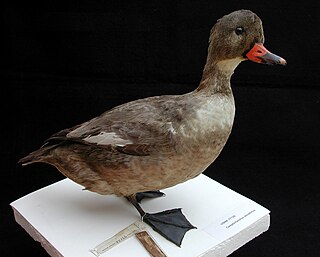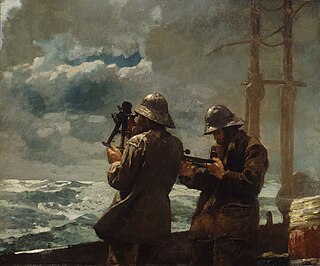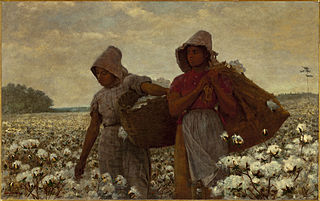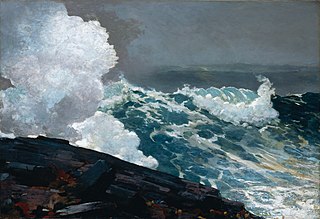
The Labrador duck is an extinct North American duck. It has the distinction of being the first known endemic North American bird species to become extinct after the Columbian Exchange, with the last known sighting occurring in 1878 in Elmira, New York. It was already a rare duck before European settlers arrived, and as a result of its rarity, information on the Labrador duck is not abundant, although some, such as its habitat, characteristics, dietary habits and reasons behind its extinction, are known. There are 55 specimens of the Labrador duck preserved in museum collections worldwide.

George Inness was a prominent American landscape painter.

Visual art of the United States or American art is visual art made in the United States or by U.S. artists. Before colonization, there were many flourishing traditions of Native American art, and where the Spanish colonized Spanish Colonial architecture and the accompanying styles in other media were quickly in place. Early colonial art on the East Coast initially relied on artists from Europe, with John White the earliest example. In the late 18th and early 19th centuries, artists primarily painted portraits, and some landscapes in a style based mainly on English painting. Furniture-makers imitating English styles and similar craftsmen were also established in the major cities, but in the English colonies, locally made pottery remained resolutely utilitarian until the 19th century, with fancy products imported.

The common goldeneye or simply goldeneye is a medium-sized sea duck of the genus Bucephala, the goldeneyes. Its closest relative is the similar Barrow's goldeneye. The genus name is derived from the Ancient Greek boukephalos, a reference to the bulbous head shape of the bufflehead. The species name is derived from the Latin clangere.

Winslow Homer was an American landscape painter and illustrator, best known for his marine subjects. He is considered one of the foremost painters of 19th-century America and a preeminent figure in American art in general.

Frank Weston Benson, frequently referred to as Frank W. Benson, was an American artist from Salem, Massachusetts known for his Realistic portraits, American Impressionist paintings, watercolors and etchings. He began his career painting portraits of distinguished families and murals for the Library of Congress. Some of his best known paintings depict his daughters outdoors at Benson's summer home, Wooster Farm, on the island of North Haven, Maine. He also produced numerous oil, wash and watercolor paintings and etchings of wildfowl and landscapes.

Waterfowl hunting is the practice of hunting aquatic birds such as ducks, geese and other waterfowls or shorebirds for food and sport.

The Gulf Stream is an 1899 oil painting by Winslow Homer. It shows a man in a small dismasted rudderless fishing boat struggling against the waves of the sea, and was the artist's statement on a theme that had interested him for more than a decade. Homer vacationed often in Florida, Cuba, and the Caribbean.

Eight Bells is an 1886 oil painting by the American artist Winslow Homer. It depicts two sailors determining their ship's latitude. It is one of Homer's best-known paintings and the last of his major paintings of the 1880s that dramatically chronicle man's relationship to the ocean.

Breezing Up (A Fair Wind) is an oil painting by American artist Winslow Homer. It depicts a catboat called the Gloucester chopping through that city's harbor under "a fair wind" (Homer's original title). Inside the boat are a man, three boys, and their catch.

The Fox Hunt is an 1893 oil on canvas painting by Winslow Homer. It depicts a fox running in deep snow, menaced by hungry crows. His largest single work, it has been described as "Homer's greatest Darwinian painting, arguably his greatest painting of any kind."

The Boat Builders is an oil painting on panel executed in 1873 by American landscape painter Winslow Homer. It is held in the collection of the Indianapolis Museum of Art (IMA), in Indianapolis, Indiana, United States.

A Visit from the Old Mistress is an 1876 painting by the prominent 19th-century American artist Winslow Homer. It was one of several works that Homer is thought to have created during a mid-1870s visit to Virginia, where he had served for a time as a Union war correspondent during the Civil War. Scholars have noted that the painting's composition is taken from Homer's earlier painting Prisoners from the Front, which depicts a group of captive Confederate soldiers defiantly regarding a Union officer. Put on display in the northern states for a northern audience, A Visit from the Old Mistress, along with Homer's other paintings of black southern life from the postbellum period, has been praised as an "invaluable record of an important segment of life in Virginia during the Reconstruction."

The Cotton Pickers is an 1876 oil painting by Winslow Homer. It depicts two young African-American women in a cotton field.
Stately, silent and with barely a flicker of sadness on their faces, the two black women in the painting are unmistakable in their disillusionment: they picked cotton before the war and they are still picking cotton afterward.

The Fog Warning is one of several paintings on marine subjects by the late-19th-century American painter Winslow Homer (1836–1910). Together with The Herring Net and Breezing Up, painted the same year and also depicting the hard lives of fishermen in Maine, it is considered among his best works on such topics.

Northeaster is one of several paintings on marine subjects by the late-19th-century American painter Winslow Homer. Like The Fog Warning and Breezing Up, he created it during his time in Maine. It is on display in the Metropolitan Museum of Art in New York. Viewers are presented a struggle of elements between the sea and the rocky shore. Winslow Homer excelled in painting landscape paintings that depicted seascapes and mountain scenery.

The Pardo Venus is a painting by the Venetian artist Titian, completed in 1551 and now in the Louvre Museum. It is also known as Jupiter and Antiope, since it seems to show the story of Jupiter and Antiope from Book VI of the Metamorphoses. It is Titian's largest mythological painting, and was the first major mythological painting produced by the artist for Philip II of Spain. It was long kept in the Royal Palace of El Pardo near Madrid, hence its usual name; whether Venus is actually represented is uncertain. It later belonged to the English and French royal collections.

Sarah Helena de Kay Gilder was an American painter, illustrator, and cultural tastemaker from New York City.

The Veteran in a New Field is an oil-on-canvas painting by the 19th-century American artist Winslow Homer. It is set in the aftermath of the American Civil War and is often interpreted as an emblem of postwar American society. The painting depicts a farmer harvesting wheat in a field with a scythe. The farmer in the painting is identified as a former Union Soldier from his discarded jacket and canteen in the right foreground of the painting. This painting was one of several that Homer did on the American Civil War, including his previous works Home, Sweet Home and Prisoners from the Front. The Veteran in a New Field is a transitional painting in Homer's body of work. It comments on the postwar return of soldiers to daily life and the history of death that they bring along with them. It uses biblical themes to comment on war and nature, while also alluding to stories from classical history.

Grace Hoops is a genre painting by the American artist Winslow Homer. It depicts two young women outdoors playing the game of graces. Scenes of childhood innocence constituted one of Homer's recurring subjects throughout the 1870s. The work is now in the collection of the McMullen Museum of Art at Boston College, having been donated as part of the Carolyn A. and Peter S. Lynch collection.






















